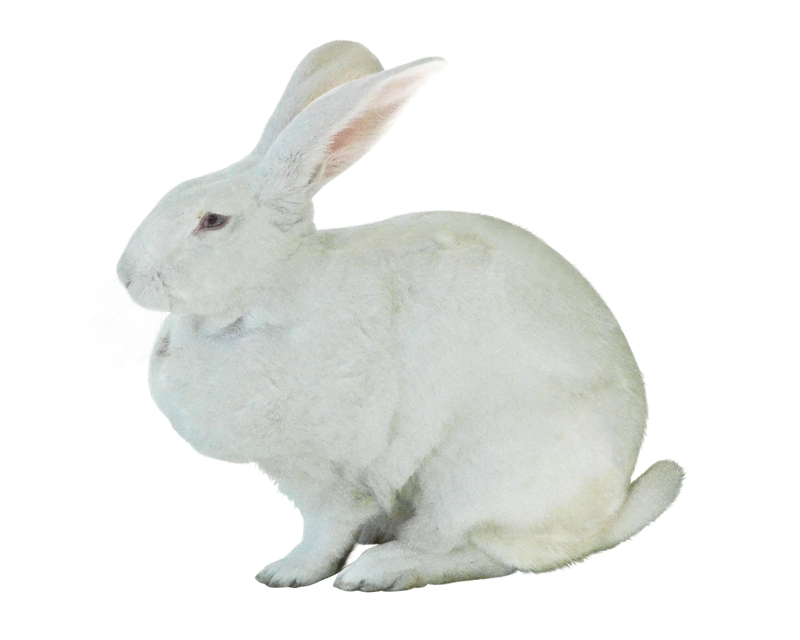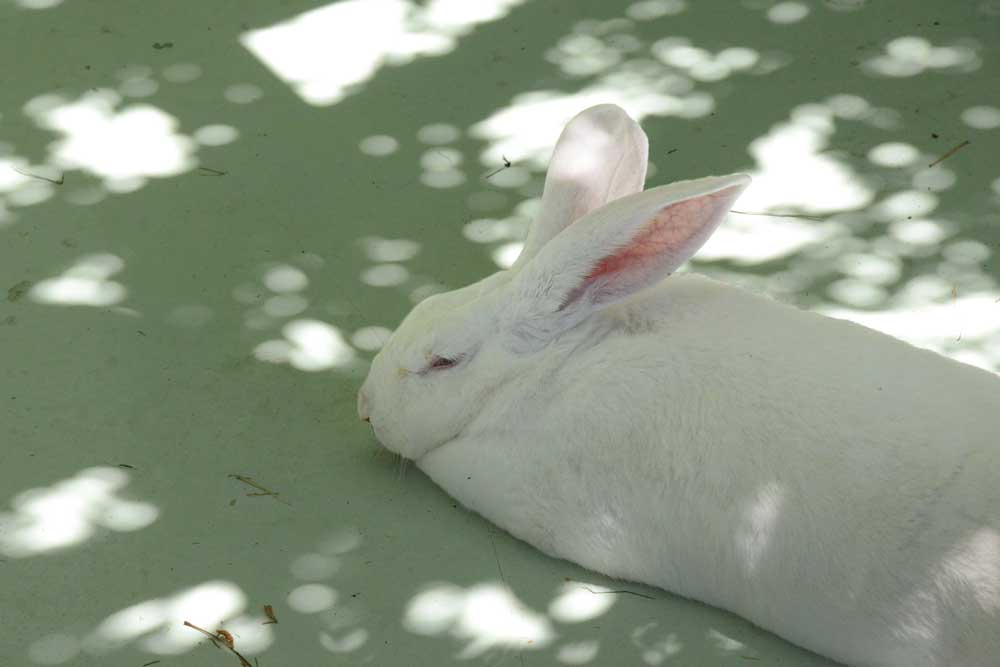
Oryctolagus cuniculus domesticus
日本人とウサギ肉
Japanese People and Rabbit Meat
秋田県大仙市中仙地区ではおよそ100年前から日本白色種のウサギを食用に改良を重ねてきました。特に体重が6kg を超えるものは「中仙ジャンボうさぎ」と呼ばれ地元の特産品になっています。
中仙地区でウサギが飼われ始めたのはは1899年のことです。農家の食生活を改善する為で、そこから農家は飼育改良が行うようになりました。1914年には大きなウサギを作出する為に、大型のメリケン種に加え、世界最大級のウサギ品種であるフレミッシュジャイアントを導入したりしています。1919年には農林大臣の早速整爾が養兎を推奨し、副業の項目に加えて養兎事業助成補助金が交付されるようになると、各町村で養兎組合が設立され、品評会が行われるようになります。1934~35年の品評会では体重が6kgを超えるウサギが出品され、そこから50年後の1984年には10kgを超える個体が作出されるようになりました。しかし、1991年から養兎家の高齢化や感染症の流行により飼育数は減少しており、現在中仙地域では飼育数100匹以下に激減しており、存続が危ぶまれています。
養兎業の衰退には二つの要因があります。秋田県おけるジャンボうさぎ飼育数の最盛期は戦時中であり、1939年(昭和16年)には16万羽を記録しています。実はその背景には政府による軍需兎毛皮増産計画があり、ウサギは食肉以前に毛皮が防寒用コートなどの軍服のために必要とされていたのです。戦争が終わり大きな需要がなくなったことが養兎業衰退の一つの要因です。もう一つは食肉としての需要を促進できなかったことだと考えられます。世界的に見ればウサギ肉は多くの国々で食べられているのですが、日本ではペットとして飼われることが多くなり、食することへの抵抗感が生じて敬遠されるようになりました。
しかし日本人は古来よりウサギ肉を食してきたのは事実です。ウサギを鳥類と同じように「羽」と数えるのは実はそのことが関係しています。江戸時代、仏教の教えで四つ足の動物が「殺生(せっしょう)」として食べてはいけないものとされました。そこで寺院関係者が「ウサギは飛び跳ねるから、鳥に近い」ので、鳥と同じように「〜羽」と数えることで、「鳥と同じだから食べても問題ない」と解釈したそうです。禁止されても食べたいと思わせるほど、当時の人たちにとってウサギ肉はご馳走だったようです。実際にウサギ肉の見た目や味は鶏肉に近く、寺院関係者のこじつけも決して的外れではないと思われます。
In the Nakasen area of Daisen City, Akita Prefecture, Japanese white rabbits have been bred for consumption for approximately 100 years. Rabbits weighing over 6 kg, known as “Nakasen Jumbo Rabbits,” have become a local specialty.
Rabbits were first kept in the Nakasen area in 1899 to improve farmers’ diets, and farmers began breeding and improving them. In 1914, in order to breed larger rabbits, they introduced the Flemish Giant, one of the world’s largest rabbit breeds, in addition to the large American breed. In 1919, Minister of Agriculture and Forestry Seiji immediately encouraged rabbit farming. Subsidies for rabbit farming were added to the list of side jobs, and rabbit-raising associations were established in each town and village, and rabbit competitions began to be held. Rabbits weighing over 6 kg were exhibited at competitions in 1934 and 1935. Fifty years later, in 1984, rabbits weighing over 10 kg were being bred. However, since 1991, the number of rabbits being raised has been declining due to the aging of rabbit breeders and the spread of infectious diseases. Currently, the number of rabbits being raised in the Nakasen region has plummeted to less than 100, putting the industry’s survival in jeopardy.
There are two factors behind the decline of the rabbit farming industry. The peak of jumbo rabbit breeding in Akita Prefecture was during wartime, with a record of 160,000 in 1939 (Showa 16). In fact, this was due to a government plan to increase rabbit fur production for military use. Rabbits were needed for winter coats and other military uniforms, rather than for meat. The end of the war and the lack of significant demand are one factor behind the industry’s decline. The other is thought to be the failure to stimulate demand for rabbit meat. While rabbit meat is eaten in many countries around the world, in Japan, rabbits are often kept as pets, which has led to a sense of resistance to eating them and a resulting shunning of the industry.
However, it is true that Japanese people have been eating rabbit meat since ancient times. This is actually related to the fact that rabbits are counted as “feathers” like birds. During the Edo period, Buddhist teachings stipulated that four-legged animals were forbidden to be eaten, as they were considered “sessho” (killing). Temple officials, therefore, interpreted this as meaning that rabbits were similar to birds because they could hop, and so by counting them as “feathers” in the same way as birds, it was okay to eat them. It seems that rabbit meat was such a delicacy for people at the time that they still wanted to eat it, even though it was forbidden. In fact, rabbit meat looks and tastes similar to chicken, so it seems that the temple officials’ far-fetched interpretation is not far off the mark.

参考文献
あきコネ | 【あきたの物語】ジャンボうさぎの可能性を知るために秋田県大仙市中仙地区を訪れてみませんか? 2025年8月14日閲覧
日本アンゴラ兎研究会 | 秋田改良種 2025年8月14日閲覧
秋田魁新報 | 中仙地域の「ジャンボうさぎ」が危機に 飼育数激減、100匹以下 | (2023年3月20日) 2025年8月14日閲覧
AminaFlyers | うさぎ肉ってどんな味?世界のうさぎ料理をご紹介! | (2023年1月10日) 2025年8月14日閲覧
世界のコトなら presented by 海外書き人クラブ | 【海外在住ライター直伝】「ウサギ料理を食べますか?」世界23ヵ国で訊きました | (2019年7月30日) 2025年8月14日閲覧
CAMPFIRE | みみみみみ! 〜秋田のためにジャンボうさぎを守る〜 2025年8月14日閲覧
LUPINUS | 育成ブログ | うさぎさんはなぜ「羽」で数えるの?ブリーダー解説 | (2025年4月6日) 2025年8月14日閲覧